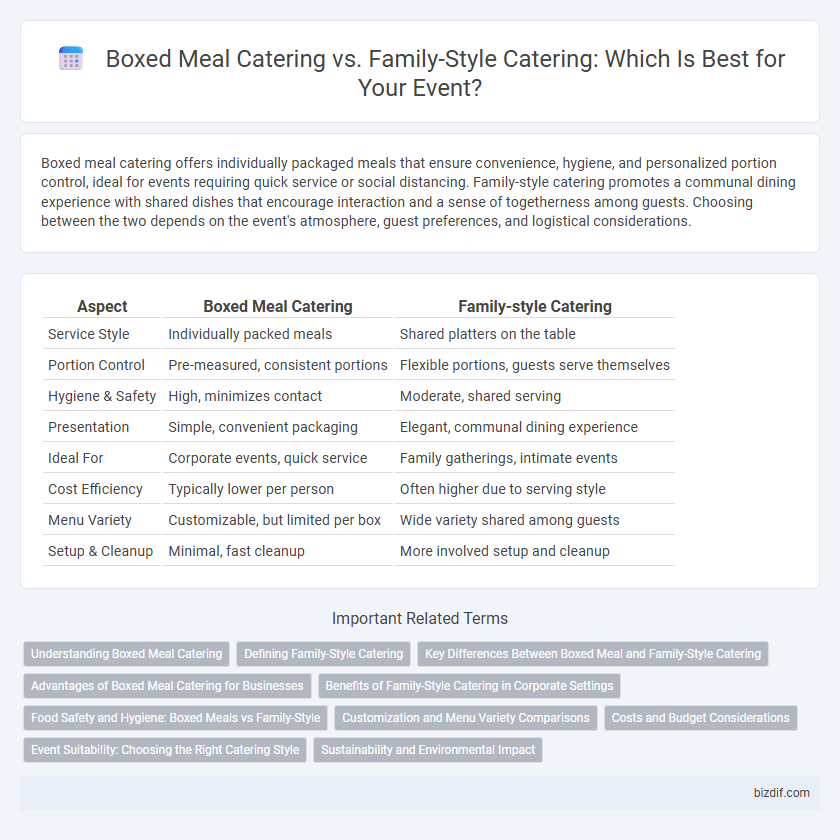Boxed meal catering offers individually packaged meals that ensure convenience, hygiene, and personalized portion control, ideal for events requiring quick service or social distancing. Family-style catering promotes a communal dining experience with shared dishes that encourage interaction and a sense of togetherness among guests. Choosing between the two depends on the event's atmosphere, guest preferences, and logistical considerations.
Table of Comparison
| Aspect | Boxed Meal Catering | Family-style Catering |
|---|---|---|
| Service Style | Individually packed meals | Shared platters on the table |
| Portion Control | Pre-measured, consistent portions | Flexible portions, guests serve themselves |
| Hygiene & Safety | High, minimizes contact | Moderate, shared serving |
| Presentation | Simple, convenient packaging | Elegant, communal dining experience |
| Ideal For | Corporate events, quick service | Family gatherings, intimate events |
| Cost Efficiency | Typically lower per person | Often higher due to serving style |
| Menu Variety | Customizable, but limited per box | Wide variety shared among guests |
| Setup & Cleanup | Minimal, fast cleanup | More involved setup and cleanup |
Understanding Boxed Meal Catering
Boxed meal catering offers individually packaged, portion-controlled meals ideal for events requiring minimal contact and efficient service, such as corporate meetings and outdoor gatherings. Each boxed meal typically includes a balanced combination of proteins, sides, and desserts to cater to diverse dietary preferences while ensuring fresh, hygienic delivery. This catering style simplifies logistics, reduces waste, and enhances personalized meal experiences compared to traditional family-style catering.
Defining Family-Style Catering
Family-style catering involves serving large platters or bowls of food that guests share at the table, promoting a communal dining experience. This catering style emphasizes interaction and variety, allowing diners to sample multiple dishes in a casual yet elegant manner. Boxed meal catering, by contrast, provides individual pre-packaged meals designed for convenience and quick distribution, often favored for efficiency in large events or when social distancing is necessary.
Key Differences Between Boxed Meal and Family-Style Catering
Boxed meal catering delivers individually packed portions, ensuring convenience, hygiene, and easy distribution, ideal for large events or quick service. Family-style catering features shared platters placed on tables, promoting interaction and a communal dining experience, suitable for smaller or more intimate gatherings. Key differences include portion control, presentation style, and the level of guest interaction facilitated by each catering type.
Advantages of Boxed Meal Catering for Businesses
Boxed meal catering offers businesses streamlined service with individually packaged meals that reduce waiting times and minimize cross-contamination risks, ensuring compliance with health standards. It enhances portion control which helps in cost management and reduces food waste, making it an economically efficient option. The convenience of boxed meals supports easy distribution at large events or meetings, boosting employee satisfaction through personalized meal choices.
Benefits of Family-Style Catering in Corporate Settings
Family-style catering enhances corporate events by fostering collaboration and communication among colleagues, creating a more engaging dining experience. This service style allows for diverse menu options and encourages sharing, which can improve team bonding and morale. The communal nature of family-style meals often leads to increased satisfaction and a more memorable event atmosphere compared to boxed meal catering.
Food Safety and Hygiene: Boxed Meals vs Family-Style
Boxed meal catering offers enhanced food safety and hygiene by providing individually packed portions that minimize cross-contamination and reduce handling. Family-style catering, while promoting shared dining experiences, poses higher risks of contamination as guests serve themselves from common dishes, increasing exposure to germs. Strict sanitation protocols are essential in both styles, but boxed meals inherently support stricter control over food safety standards.
Customization and Menu Variety Comparisons
Boxed meal catering offers high customization through individually portioned meals tailored to diverse dietary preferences, ensuring ease of distribution and personalized variety. Family-style catering emphasizes shared platters with flexible menu options designed for communal dining, promoting interaction but limiting individual choice customization. Both styles provide menu variety, yet boxed meals excel in personalized customization, while family-style dining delivers a curated selection of dishes fostering a collective experience.
Costs and Budget Considerations
Boxed meal catering generally offers a cost-effective option, with predictable pricing per individual that simplifies budgeting for events and reduces food waste through portion control. Family-style catering may incur higher costs due to larger servings and more varied dishes, requiring more staff for service and potentially increasing overall expenses. Evaluating event size, guest preferences, and service needs is crucial to balance budget constraints with an engaging dining experience.
Event Suitability: Choosing the Right Catering Style
Boxed meal catering offers personalized portions ideal for large-scale events requiring quick, hygienic service and minimal interaction, such as corporate meetings or outdoor gatherings. Family-style catering promotes shared dishes and communal dining, enhancing social engagement and is best suited for intimate celebrations like weddings or family reunions. Selecting the right catering style depends on event size, guest interaction preferences, and service logistics to ensure optimal dining experiences.
Sustainability and Environmental Impact
Boxed meal catering reduces food waste by offering pre-portioned servings, minimizing leftovers and excess packaging that can be recycled or composted, which decreases the environmental footprint compared to family-style catering. Family-style catering often leads to increased food waste due to larger, shared dishes and tendency for uneaten portions, generating more organic waste that requires efficient composting systems to mitigate environmental damage. Choosing sustainable materials and optimizing food quantities in both styles significantly impacts overall resource consumption, with boxed meals showing a clear advantage in waste reduction and carbon footprint management.
Boxed Meal Catering vs Family-style Catering Infographic

 bizdif.com
bizdif.com